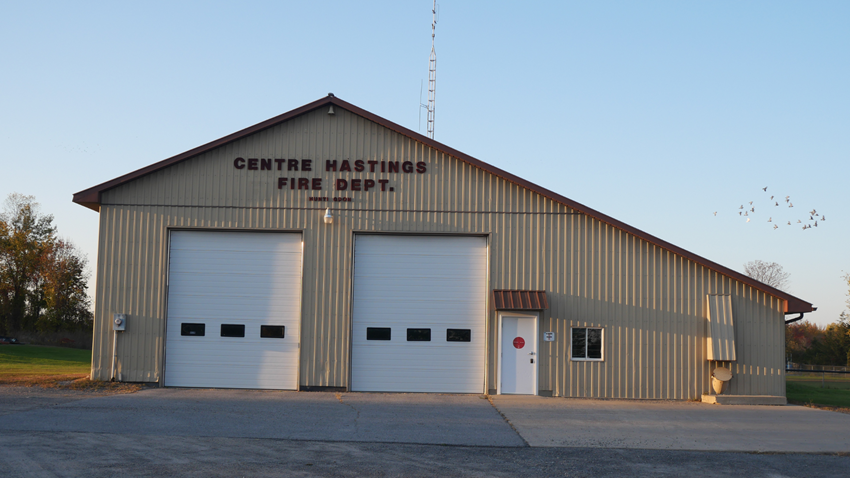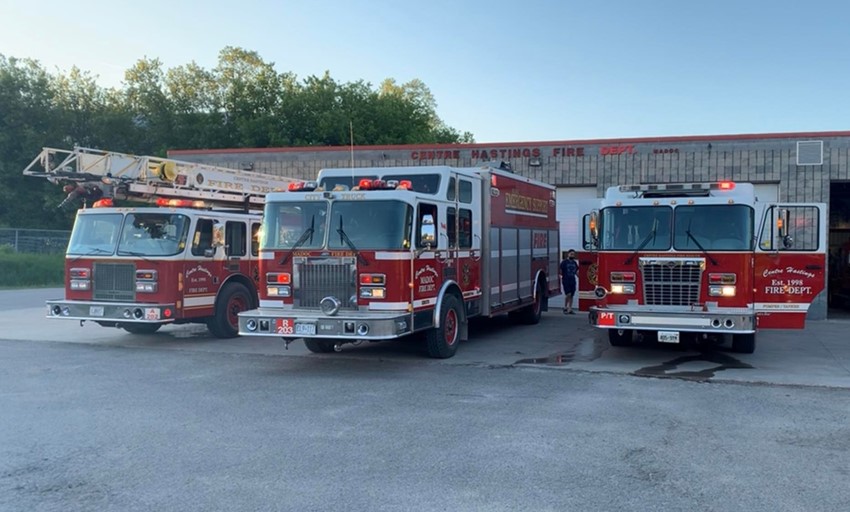Fire Department
Fire Department
The Centre Hastings Fire Department is comprised of two fire stations with 40 volunteer professional firefighters. The Department is led by Fire Chief Derek Snider.
In addition to firefighting and life-saving services, the Department's emphasis is on fire prevention, providing fire inspection, and fire education programs throughout the community.
Station 1: South Hall
Station 1 is located in Ivanhoe, operating in the southern sector of the Municipality of Centre Hastings.

Station 2: North Hall
Station 2 is located in the village of Madoc, operating in the northern sector of the Municipality of Centre Hastings.

The Centre Hastings Fire Department is proud to announce its successful achievement of the Superior Tanker Shuttle Accreditation. This accreditation is a significant milestone for the department and brings tangible benefits to the residents of Centre Hastings.
The Superior Tanker Shuttle Accreditation ensures that the fire department can provide an uninterrupted water supply during fire emergencies, even in areas not serviced by hydrants. This process demonstrates the department’s ability to deliver water to rural locations in a timely and efficient manner, equivalent to having a fire hydrant on-site.
With this accreditation, residents of Centre Hastings can potentially benefit from reduced insurance premiums, as it assures insurance providers that the community has enhanced fire protection services. Achieving this status highlights the dedication and hard work of the entire fire department team, reinforcing its commitment to the safety and protection of the community.
Centre Hastings Fire Department continues to strive for excellence, ensuring the highest standards in fire protection for all its residents.
Derek Snider, Fire Chief
Centre Hastings Fire Department



Fire Safety Tips

January has marked as a busy beginning for the Centre Hastings Fire Department in 2025, with numerous incidents concerning carbon monoxide. As the temperatures drop and we spend more time indoors, the risk of carbon monoxide exposure increases, making it crucial for everyone to be aware of the potential dangers.
Carbon monoxide is a colorless, odorless gas that can be produced by various household appliances, such as furnaces, water heaters, and stoves, especially if they are not functioning properly or are poorly ventilated. In high concentrations, carbon monoxide can lead to serious health issues, including headaches, dizziness, confusion, and in extreme cases, it can be life-threatening.
To ensure the safety of you and your families during these colder months, we wish to offer some valuable advice:

- Install smoke alarms on every level of the home, including the basement
- Install smoke alarms inside or outside of every sleeping area
- Install carbon monoxide alarms in bedrooms or near sleeping areas
- Mount smoke alarms on the ceiling or high on the wall
- Avoid installing smoke alarms near windows, doors, or ducts

- Test smoke alarms at least once a month
- Test carbon monoxide alarms at least twice a year if they are battery operated
- Make sure smoke alarms are audible and wake you up

- Replace smoke alarms every 10 years
- Replace carbon monoxide alarms every 5 to 10 years
- Gently vacuum smoke alarms every six months

- If you suspect carbon monoxide poisoning, open doors and windows, get outside, and call emergency services
- Seek emergency medical attention for symptoms of carbon monoxide poisoning
Chimney Fire Prevention Tips from Centre Hastings Fire Department

As temperatures drop, many of us enjoy the comfort of a warm fire. However, a neglected chimney can pose serious risks. Chimney fires, often caused by creosote buildup or improper use, can spread rapidly and endanger your home and family.
Taking these simple steps will help you enjoy a fire-lit home safely. If you have questions or need more fire safety information, contact the Centre Hastings Fire Department.
Your Safety Is Our Priority
Centre Hastings Fire Department
An annual chimney inspection and cleaning by a certified professional is essential. This helps remove creosote, a highly flammable residue that accumulates from wood smoke.
Only burn dry, seasoned hardwood. Wet or green wood produces more smoke and creosote, increasing fire risk. Avoid burning treated wood or garbage, as these can release harmful chemicals.
A cap keeps out debris, like leaves and animal nests, which can block airflow and ignite.
Always open the damper before lighting a fire, and ensure your chimney drafts properly to vent smoke and gases. Keep fires small and hot to reduce smoke production and creosote buildup.
Watch for warning signs such as slow-burning fires or a strong, tar-like odor, which could indicate a blockage or buildup.
Install smoke and carbon monoxide detectors near sleeping areas, and always use a sturdy screen or door to prevent sparks from escaping.

Municipality of
Centre Hastings
7 Furnace Street,
PO Box 900,
Madoc, ON K0K 2K0
Phone: 613-473-4030



